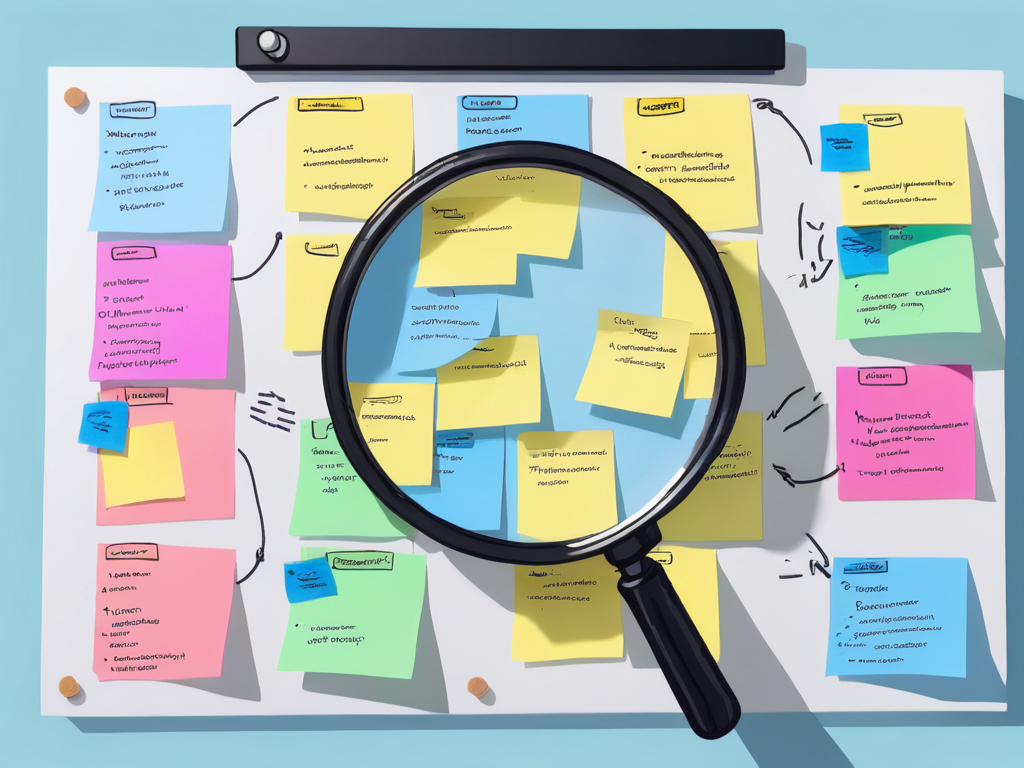· Santiago · tutorials · 10 min read
5 Tips for Improving Collaboration in Scrum
Maximize Scrum collaboration with these 5 key tips. From effective communication to harnessing team dynamics, elevate your agile process for optimal results.

Collaboration is key to success in Scrum. By working together effectively, Scrum teams can deliver high-quality products and achieve their goals. However, improving collaboration in Scrum is not always easy. It requires effort and a focus on building strong relationships among team members. In this article, we will explore five valuable tips that can help you improve collaboration in your Scrum team. Let’s dive in!
Understanding the Importance of Collaboration in Scrum
Before we discuss the tips, let’s first understand why collaboration is so crucial in Scrum. Collaboration enables team members to share their expertise, knowledge, and ideas, leading to better decision-making and problem-solving. It fosters a sense of ownership and accountability among the team, as everyone is actively involved in the project’s success. Effective collaboration enhances communication, increases productivity, and promotes a healthy work environment.
The Role of Collaboration in Scrum Success
Collaboration plays a vital role in achieving success in Scrum. It encourages cross-functional teams to work together, breaking down silos and enabling faster delivery of value. By promoting team collaboration, members can address complex challenges collectively, leveraging each other’s strengths and mitigating weaknesses. Collaborative teams are more adaptable and flexible, allowing them to respond effectively to changes in requirements or market conditions.
Key Challenges in Scrum Collaboration
While collaboration is essential, it can sometimes face challenges in the Scrum framework. One common challenge is communication barriers that can arise due to cultural differences, time zone disparities, or language barriers. Additionally, conflicting priorities, lack of trust, and poor interpersonal skills can hinder effective collaboration. Identifying and addressing these challenges is crucial for fostering a collaborative work environment.
Another challenge that can arise in Scrum collaboration is the presence of dominant personalities within the team. These individuals may have strong opinions and tend to overshadow others, stifling the collaborative spirit. It is important for Scrum Masters and team leaders to create an inclusive environment where every team member feels comfortable expressing their ideas and opinions.
Furthermore, geographical dispersion can also pose a challenge to collaboration in Scrum. With team members located in different regions or even countries, it can be difficult to establish effective communication channels and maintain a cohesive team dynamic. Utilizing technology tools and platforms that facilitate virtual collaboration, such as video conferencing and project management software, can help overcome these challenges and foster collaboration among geographically dispersed teams.
Tip 1: Encourage Open Communication
Open communication is the cornerstone of effective collaboration. It is essential to establish a culture where team members feel comfortable expressing their thoughts, ideas, and concerns openly. Encourage active listening and create channels for transparent communication. Regularly scheduled team meetings, such as daily stand-ups or retrospectives, provide opportunities for everyone to share updates and provide feedback.
The Value of Transparency in Scrum Teams
In Scrum, transparency is crucial for collaboration. Transparency ensures that all team members have access to the same information, creating a level playing field. This enables better decision-making and alignment within the team. Transparent processes, such as visual boards or digital project management tools, allow team members to track progress, identify bottlenecks, and collaborate effectively.
Tools and Techniques for Effective Communication
To facilitate open communication, leverage various tools and techniques. Online collaboration platforms, such as Slack or Microsoft Teams, enable real-time communication and quick information sharing. Additionally, using video conferencing tools for remote team members encourages face-to-face interaction, promoting a sense of connection and collaboration.
The Role of Emotional Intelligence in Communication
Emotional intelligence plays a significant role in fostering open communication within teams. It involves understanding and managing emotions effectively, both in oneself and in others. Team members with high emotional intelligence can navigate conflicts, build trust, and foster a positive team environment. Encouraging emotional intelligence development through training and workshops can enhance communication and collaboration.
Cultural Considerations in Communication
When working in diverse teams, it’s essential to consider cultural differences that may impact communication. Cultural norms, values, and communication styles vary across different regions and backgrounds. Being mindful of these differences can help prevent misunderstandings and promote effective communication. Embracing cultural diversity within teams, with the guidance of a scrum master, can lead to innovative ideas and a richer collaborative experience.
Tip 2: Foster Trust Among Team Members
Trust is a crucial element of collaboration within Scrum teams. When team members trust each other, they are more likely to share knowledge, take risks, and support one another. Trust creates a safe environment where individuals feel comfortable expressing their opinions and challenging existing ideas.
Trust within a team is like the glue that holds all the pieces together. It is the foundation upon which successful collaboration is built. When team members trust each other, they are more willing to communicate openly, brainstorm innovative ideas, and work towards a common goal. This sense of trust fosters a positive team dynamic where individuals feel valued and respected.
Building Trust in a Scrum Environment
Building trust starts with setting clear expectations and providing regular feedback. Encourage open dialogue and constructive conflict resolution, facilitated by the scrum master. Celebrate individual and team achievements, recognizing the contributions of each team member. By fostering trust, with the guidance of a scrum master, you promote collaboration among team members, allowing them to work together more effectively and produce outstanding results.
Additionally, creating opportunities for team bonding activities can also strengthen trust among team members. Whether it’s a team lunch, a virtual game night, or a collaborative project outside of work, these activities help build personal connections and deepen relationships. Trust is not only built on professional interactions but also on a foundation of mutual understanding and respect.
The Impact of Trust on Team Performance
Studies have shown that teams with higher levels of trust perform better. Trust reduces the time spent on politics and encourages open cooperation. When team members trust each other, they are more likely to share information, ask for help when needed, and take ownership of their responsibilities. This leads to higher productivity and a more positive work environment.
Furthermore, trust has a ripple effect on team performance. When trust is present, team members are more willing to collaborate, take calculated risks, and innovate. This results in a team that is not only efficient in its processes but also resilient in the face of challenges. Trust acts as a catalyst for creativity and problem-solving, enabling teams to adapt to changing circumstances and deliver exceptional results consistently.
Tip 3: Promote Active Participation
In Scrum, active participation is essential for effective collaboration. All team members should have equal opportunities to contribute and be involved in decision-making processes. By promoting active participation, you harness the collective intelligence of the team and capitalize on diverse perspectives.
Active participation goes beyond just attending meetings or providing input when prompted. It involves proactive engagement and a willingness to collaborate openly with team members. When team members actively participate, they take ownership of their work and contribute to the overall success of the project.
The Importance of Inclusivity in Scrum Meetings
Scrum meetings, such as Sprint Planning or Daily Stand-ups, provide valuable opportunities for active participation. Ensure that all team members feel included and encouraged to share their thoughts during these meetings. Avoid dominating voices and actively invite input from quieter team members. Inclusivity promotes collaboration and enhances team dynamics.
Creating a culture of inclusivity in Scrum meetings fosters a sense of belonging and psychological safety among team members. When individuals feel valued and respected for their contributions, they are more likely to actively participate and engage in meaningful discussions. Inclusivity also promotes diversity of thought, leading to innovative solutions and improved decision-making.
Strategies for Ensuring Active Participation
Implement strategies to ensure active participation, such as rotating meeting facilitators or using brainstorming techniques to encourage idea generation. Utilize collaboration tools to facilitate communication and coordination among team members. Create a safe space where individuals feel empowered to express their opinions and challenge the status quo. By actively involving all team members, including the scrum master, you tap into their collective wisdom and foster a culture of team collaboration.
Encouraging active participation can also involve setting clear expectations for team members and providing regular feedback on their contributions. Recognizing and rewarding active participation can further motivate team members to engage fully in Scrum processes. By establishing a culture that values and promotes active participation, teams can achieve higher levels of productivity and innovation.
Tip 4: Implement Regular Feedback Cycles
Feedback is a powerful tool for improving collaboration within Scrum teams. Regular feedback cycles enable individuals to learn from each other, identify areas for improvement, and adapt their behavior accordingly. It fosters a culture of continuous improvement and helps team members grow both individually and collectively.
Implementing regular feedback cycles is not just about pointing out mistakes; it’s about creating a safe space for open communication and growth. By embracing feedback as a fundamental aspect of teamwork, Scrum teams can build trust, enhance transparency, and foster a supportive environment where everyone’s input is valued.
The Role of Feedback in Continuous Improvement
Feedback is essential for identifying strengths and areas that need development. By providing constructive feedback, team members can offer insights and suggestions for improvement. Regular feedback cycles, such as Sprint Retrospectives and the daily scrum, provide opportunities to reflect on the team’s collaboration and make adjustments to enhance future performance.
Moreover, feedback plays a crucial role in promoting a growth mindset within Scrum teams. It encourages individuals to view challenges as opportunities for learning and development, rather than obstacles. By embracing feedback with a positive attitude, team members can leverage it as a catalyst for personal and professional growth.
Tips for Constructive Feedback in Scrum
To ensure that feedback is constructive and well-received, focus on specific behaviors or actions rather than personal attacks. Use the “sandwich method,” where constructive feedback is sandwiched between positive comments, to provide a balanced approach. Additionally, encourage a feedback culture where team members feel comfortable giving and receiving feedback openly during the daily scrum and other collaborative meetings.
Creating a feedback-rich environment requires empathy, active listening, and a commitment to continuous improvement. It’s not just about giving feedback; it’s about actively seeking it to gain different perspectives and insights. By embracing feedback as a collaborative tool for growth, Scrum teams can enhance their effectiveness, strengthen their relationships, and achieve greater success in their projects.
Conclusion
In conclusion, improving collaboration in Scrum is essential for achieving team success. By following these five tips - encouraging open communication, fostering trust among team members, promoting active participation, implementing regular feedback cycles, and embracing a feedback culture - you can enhance collaboration within your Scrum team. Remember, collaboration is a journey, and it requires dedication and continuous effort from all team members. By fostering a collaborative work environment, you can unlock the full potential of your Scrum team and deliver exceptional results.
Enhance Your Scrum Collaboration with DailyBot
Ready to take your Scrum team’s collaboration to the next level? With DailyBot, you can streamline your workflows and foster transparency within your remote team. Say goodbye to endless meetings with DailyBot’s “Check-ins” feature, allowing you to skip daily standups and share progress updates directly in your favorite chat platforms like Slack, Google Chat, Discord, and Microsoft Teams. Keep your projects aligned with your goals by integrating with tools like GitHub or Jira, and celebrate your team’s achievements with Kudos, all while enjoying the convenience of an AI-assistant at your fingertips. Don’t miss the opportunity to transform your team’s productivity. Try DailyBot for free today and experience the power of enhanced collaboration.





